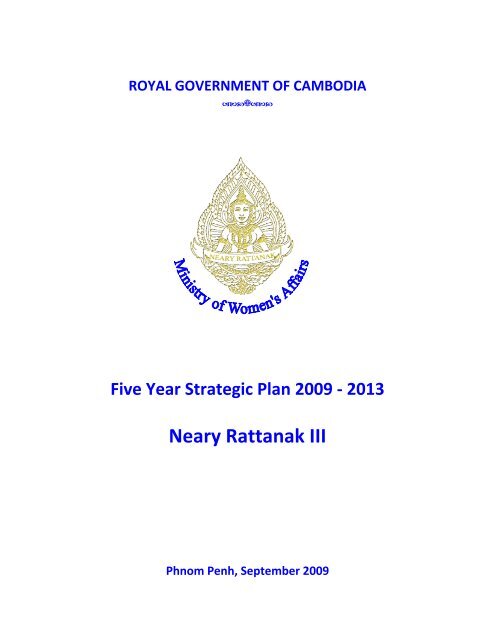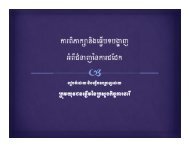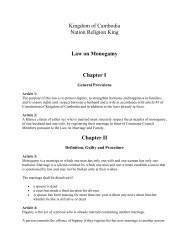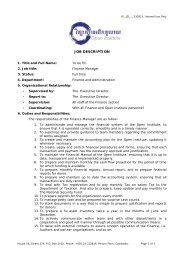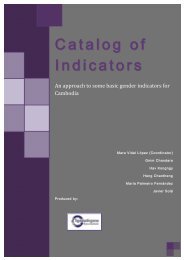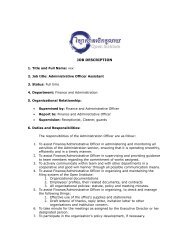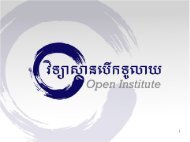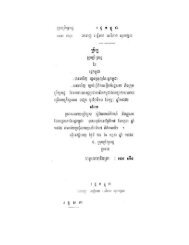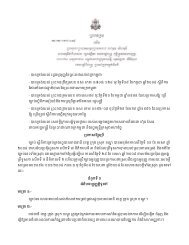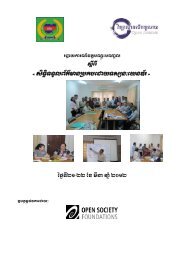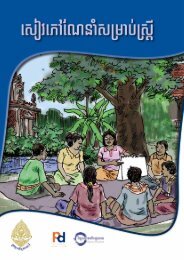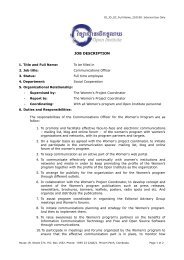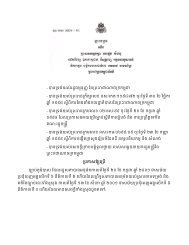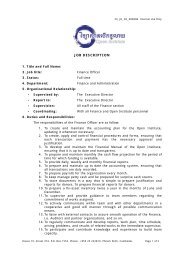Five Year Strategy - Neary Rattanak III - wmc.org.kh
Five Year Strategy - Neary Rattanak III - wmc.org.kh
Five Year Strategy - Neary Rattanak III - wmc.org.kh
- No tags were found...
Create successful ePaper yourself
Turn your PDF publications into a flip-book with our unique Google optimized e-Paper software.
ROYAL GOVERNMENT OF CAMBODIA<strong>Five</strong> <strong>Year</strong> Strategic Plan 2009 ‐ 2013<strong>Neary</strong> <strong>Rattanak</strong> <strong>III</strong>Phnom Penh, September 2009
Foreword<strong>Neary</strong> <strong>Rattanak</strong> <strong>III</strong> is the five‐year strategic plan (2009 – 2013) for Gender Equality and theEmpowerment of Women in Cambodia.On behalf of MoWA, CNCW, TWG‐Gender and all Cambodian women, I would like to informthat:In accordance with the current situation in the country and the Phase II of the Rectangular<strong>Strategy</strong> for Growth, Employment, Equity and Efficiency, the Ministry of Women’s Affairs inpartnership with relevant ministries/institutions and other partners, has developed thestrategic plan <strong>Neary</strong> <strong>Rattanak</strong> <strong>III</strong> to contribute to the government’s continuous effort inpromoting gender equality and the empowerment of women in Cambodia. The strategic planhas been prepared based on the results of the review of achievements of the former strategicplan, the <strong>Neary</strong> <strong>Rattanak</strong> II (2004–2008) and the findings and recommendations in theCambodia Gender Assessment “A Fair Share for Women” 2008.<strong>Neary</strong> <strong>Rattanak</strong> <strong>III</strong> contributes to gender mainstreaming in key government reform programssuch as Decentralization and Deconcentration Reform, Public Administration Reform, PublicFinancial Management Reform, Legal and Judicial Reform, and Land Reform. It also reflects thecontributions and linkages to the implementation of national plans and policies including theCambodian Millennium Development Goals; the National Strategic Development Plan; theEducation for All policy; the National Action Plan to Combat Violence Against Women; theNational Program on the Promotion of Social Morality and Women’s Value; the National ActionPlan on the Suppression of Human Trafficking and Sexual Exploitation; the Social Security Policy;the Strategic Plan on Women, Girls and HIV/AIDS; and the sectoral Gender MainstreamingAction Plans. Moreover, <strong>Neary</strong> <strong>Rattanak</strong> <strong>III</strong> responds to priority development issues inCambodia, and incorporates regional and international cooperation and commitments.In the process of developing this strategic plan, there was good discussion, cooperation, andpartnership with line ministries/institutions and other stakeholders at both the national andsub‐national levels, including development partners and NGOs. This has contributed to acomprehensive strategy which addresses the remaining challenges and gender inequalities inCambodia.It is my sincere hope that government ministries/institutions, NGOs/civil society anddevelopment partners will continue their support and close cooperation in making theimplementation of <strong>Neary</strong> <strong>Rattanak</strong> <strong>III</strong> successful, for the benefit of Cambodian women and thenation as a whole.Phnom Penh, September 2009Minister of Women’s Affiars
Table of ContentIntroduction 1Section I:Progress on Promotion of Gender Equality and the Empowerment ofWomen in Cambodia1. Achievements in the implementation of <strong>Neary</strong> <strong>Rattanak</strong> II2. Current Situation and Key Challenges3. Laws and national policies responding to women’s empowermentand women’s rights2Section II: Vision and Goals 7Section <strong>III</strong>:Priority Strategies for <strong>Neary</strong> <strong>Rattanak</strong> <strong>III</strong>Strategic AreasGender Mainstreaming ProgramCross‐Cutting Area8Section IV: Monitoring and Evaluation 14Section V:Mechanisms for Promotion of Gender Equality and theEmpowerment of Women in Cambodia15Annex: 5‐<strong>Year</strong> Strategic Plan “<strong>Neary</strong> <strong>Rattanak</strong> <strong>III</strong>” Implementation Matrix 17
IntroductionThe Ministry of Women's Affairs (MOWA) and the Cambodia National Council for Women(CNCW) make up the National Machinery for the promotion of gender equality and theempowerment of women. The MOWA acts as a catalyst and advocate to encourage publicinstitutions, civil society and the private sector to integrate gender equality into their policiesand programs, and as a coordinator and facilitator. It is responsible for monitoring andevaluating policies and programs to assess their contributions to achieving the Government’sgoals in promoting gender equality and the empowerment of women.In 1999, MoWA prepared and implemented its five year strategic plan, called “<strong>Neary</strong><strong>Rattanak</strong>”. In 2003, MoWA in partnership with line ministries/institutions at national and subnationallevel reviewed the effectiveness and efficiency of the implementation of thestrategic plan “<strong>Neary</strong> <strong>Rattanak</strong> I” and developed “<strong>Neary</strong> <strong>Rattanak</strong> II” which was considered animportant part of the Rectangular <strong>Strategy</strong> of the Royal Government of Cambodia in its thirdmandate.In 2008, in the fourth mandate of the Royal Government, and under the leadership ofSamdach Aka Moha Sena Padei Techo Hun Sen, the Prime Minister of the Kingdom ofCambodia, the Rectangular <strong>Strategy</strong> for Growth, Employment, Equity and Efficiency, Phase IIwas established, which recognizes that “women are the backbone of the economy andsociety”. In this context, MoWA has developed its third 5‐year strategic plan, the <strong>Neary</strong><strong>Rattanak</strong> <strong>III</strong>. The strategy aims to ensure gender responsive national policies, legislation andreform programs; to support the economic empowerment of women; ensure legal protectionfrom violence and sexual and labor exploitation; to promote change in attitude and behaviorthat discriminate against women; to develop the capacity of women; and address barriers inorder for women to access and claim their right to fully participate and benefit fromeconomic and social development, also as decision‐makers.<strong>Five</strong> <strong>Year</strong> Strategic Plan 2009 – 2013 “<strong>Neary</strong> <strong>Rattanak</strong> <strong>III</strong>”1
Section I:Progress on Promotion of Gender Equality and theEmpowerment of Women in CambodiaI. Achievements in Implementation of the <strong>Neary</strong> <strong>Rattanak</strong> <strong>III</strong>n March 2008, the Ministry of Women’s Affairs (MoWA) in partnership with its developmentpartners <strong>org</strong>anized a congress to review the implementation of its second <strong>Five</strong> <strong>Year</strong> StrategicPlan, the <strong>Neary</strong> <strong>Rattanak</strong> II (2004‐2008), and to identify future directions for <strong>Neary</strong> <strong>Rattanak</strong><strong>III</strong> (2009‐2013).In implementing the <strong>Five</strong> <strong>Year</strong> <strong>Strategy</strong>, the Royal Government of Cambodia , through MoWAand line ministries and relevant partners, had successfully contributed to promoting genderresponsive national policy and legislation; increasing women’s participation in decisionmakingat all levels; economic empowerment of women; combating violence against women,and the development of related laws and law enforcement; improved health of women andgirls, HIV/AIDS prevention and nutrition for women and children; participation of girls ineducation, and adult women in literacy programs; and the promotion of social values.There is a clear shift from agriculture to industry and services for both men and women;wage employment has increased and women’s share of wage employment has achievedparity in agriculture and industry. Through the Women’s Development Centers, women havereceived vocational training and counseling on entrepreneurship development to increasetheir employment opportunities and improve their livelihood options, with the overall aim ofeconomic development.Excellent progress has been achieved in higher enrollment rates and increased gender parityat the primary school level. Enrollment rates and gender parity has also improved at higherlevels of education. Near gender equity in literacy rates and mean level of education amongyoung people under 20 years of age has been achieved, a reflection of the significantimprovements in the primary education system. Institutions responsible for educationcontinue to consider gender concerns in education sector policy development.Very good progress has also been achieved in strengthening the legal framework to protectwomen. Awareness and understanding of gender equality and women’s rights have beenraised and incorporated in the preparation and implementation of laws and training. In 2005,the Law on the Prevention of Domestic Violence and Protection of Victims was adopted bythe National Assembly, and the related National Action Plan to Combat Violence againstWomen has been adopted by the Council of Ministers. The Law on Suppression of HumansTrafficking and Sexual Exploitation was adopted in 2008 and the National Action Plan is underpreparation.In the health sector, excellent progress has been achieved in advancing the health status ofwomen and girls, in improved awareness of their rights, and in improved access to primaryhealth care, use of vaccines and, as well as in information on HIV/AIDS and prevention ofsexually transmitted diseases (STD) and malaria. The overall HIV adult prevalence rate was<strong>Five</strong> <strong>Year</strong> Strategic Plan 2009 – 2013 “<strong>Neary</strong> <strong>Rattanak</strong> <strong>III</strong>”2
Violence against WomenVery good progress has also been achieved in strengthening the legal framework to addressviolence against women including: the Law on the Prevention of Domestic Violence andProtection of Victims; the related National Action Plan to Combat Violence Against Women;and the Law on Suppression of Trafficking in Humans and Sexual Exploitation, which isconsistent with the UN Protocol to Prevent, Suppress and Punish Trafficking in Persons,Especially Women and Children. However, violence against women remains widely prevalentin Cambodia with indications of increasing incidence of at least some forms of gender‐basedviolence, particularly rape. Putting into place the administrative mechanisms and guidelinesfor effective implementation of new laws, and addressing the attitudes and behavior whichunderlie gender‐based violence and the stigmatization of survivors and victims of violenceremain a considerable challenge.Women in Public Decision‐making and PoliticsAlthough there is considerable increase in women’s participation in the legislative branchincluding the Senate, National Assembly, Capital, Provincial, Municipal, District, Khan,Commune/Sangkat Councils and Board of Governors, representation of women in theexecutive branch of government remains low, particularly in senior decision‐making positionsat the national level and in provincial and district administration. There are also very fewwomen represented in the judicial branch – as judges, prosecutors or lawyers.Key challenges remain to be addressed in the promotion of women’s participation indecision‐making; these include traditional beliefs and stereotyping, that women are not wellsuited for high positions and decision‐making. The additional burden women face in their roleas care‐givers and household work remain considerable barriers for women to participatefully in decision‐making. Moreover, many women lack experience in leadership andmanagement in politics and public office. Capacity development specifically targeting womenin this field is important.Gender MainstreamingAlthough, there is good progress in mainstreaming gender in policies, programs andmechanisms to support gender mainstreaming at national and sub‐national levels thecapacity for gender analysis and evidence‐based advocacy remains weak. Harmonizinggender mainstreaming plans with sector strategies and monitoring mechanisms, andmobilizing adequate resources for effective implementation, remains a challenge.<strong>III</strong>. Laws and National Policies Responding to Women’s Empowerment and RightsTo date, Cambodia has developed and adopted several laws and policies that protect therights, freedoms, and welfare of Cambodian women and men.The Constitution of Cambodia, adopted in 1993 clearly states that “men and women haveequal rights before the law and enjoy equal participation in political, economic, social andcultural life; equality in marriage and family; employment and equal pay for the same work. Italso includes measures to prevent and eliminate of all forms of discrimination andexploitation of women”.<strong>Five</strong> <strong>Year</strong> Strategic Plan 2009 – 2013 “<strong>Neary</strong> <strong>Rattanak</strong> <strong>III</strong>”5
The Rectangular <strong>Strategy</strong> for Growth, Employment, Equity and Efficiency, Phase II,recognizes that “women are the backbone of the economy and society”. The governmentcontinues to implement policies and make provisions for increasing the enrollment of girls informal education through increased scholarships, dormitories, ensuring safety for girls andincrease the number of women teachers; promote women in decision‐making and providetraining and skills for women at all levels; increasing women’s participation in civil service andpublic administration; capacity development of women to stand as candidates for communecouncil elections, increase job opportunities for women and protect their rights; continue tosupport entrepreneurship development and provide micro‐ and small credit for women; andcontinue to implement the law on prevention of domestic violence and protection of victimsthrough provision of timely and effective protection and services to victims by cooperatingwith relevant institutions and development partners.The National Strategic Development Plan and the Cambodia Millennium DevelopmentGoals highlight the government’s commitment to reduce gender disparities in alldevelopment sectors and the need to put in place effective measures to remove barriers thatwomen face, and increase opportunities for women to fully participate and benefit fromdevelopment. In addition, the third goal of the CMDG focuses on promotion of genderequality and the empowerment of women through reducing gender gaps in education at alllevels, increasing women’s participation in government and ensuring equal wages betweenmen and women.Cambodia has signed and ratified the international Convention on the Elimination of AllForms of Discrimination Against Women (CEDAW) on September 22, 1992. This Conventionincludes recommendations to reduce exploitation and discrimination against women and toincrease measures to promote women’s status and rights. CEDAW provides a basis forequality between men and women by ensuring equal opportunity in public and political lifeincluding participation in election, standing for election, access to education, health andemployment. Moreover, the Convention stipulates that each member state must createappropriate measures, including laws and affirmative action, to ensure the rights andfreedom of women.<strong>Five</strong> <strong>Year</strong> Strategic Plan 2009 – 2013 “<strong>Neary</strong> <strong>Rattanak</strong> <strong>III</strong>”6
7. Attention paid to factors enabling and supporting the participation and retentionof girls in the formal education systemBased on the above targets, including gender mainstreaming in the area of education, thestrategic plan <strong>Neary</strong> <strong>Rattanak</strong> <strong>III</strong> 2009‐2013 will contribute to the following indicators:Key Indicators and TargetsIndicator Actual Target<strong>Year</strong> Value <strong>Year</strong> ValueProportion of 6‐14 year olds out of school 2005 12.3 2015 0Ratio of girls to boys in primary education 2007 88.4 2015 100Ratio of girls to boys in lower secondary school 2007 83.9 2015 100Ratio of girls to boys in upper secondary school 2007 66.4 2015 100Ratio of females to males in tertiary education 2006 47.9 2015 85Ratio of literate females to males, 15‐24 years old 2005 90 2015 100Proportion of women teachers 2006 40.1 2010 50Proportion of women principals 2005 7.7 2010 26Proportion of women vice principals 2005 9.2 2015 100Strategic Area 3: Legal Protection of Women and GirlsThe objective of strategic area 3 is to ensure that women and girls gain equal access to legalprotection, and to their human rights and that gender issues are taken into consideration in thepreparation, and implementation of laws and legal training, that public awareness is developed andprovision is made for care and rehabilitation for victims of gender‐based violence.Expected Output / Targets:8. Legal protection improved against all forms of violence against women andchildren, including domestic violence, human trafficking, sexual and laborexploitation9. Improved access and trust in judicial system for victims enhanced includingdomestic violence, rape, human trafficking, sexual and labor exploitation10. Improved access to psychosocial and health‐related services for victims of GBV,HT, rape, sexual harassment and exploitation11. Bilateral, regional and international cooperation mechanisms strengthened toprotect and combat trafficking and to assist victimsBased on the above targets, including gender mainstreaming in the area of legal protection,the strategic plan <strong>Neary</strong> <strong>Rattanak</strong> <strong>III</strong> 2009‐2013 will contribute to the following indicators:Key Indicators and TargetsIndicator Actual Target<strong>Year</strong> Value <strong>Year</strong> ValueProportion of the population aware of domestic2010 50violence as a crimeProportion of population aware that violence against 2005 4.5 2010 50<strong>Five</strong> <strong>Year</strong> Strategic Plan 2009 – 2013 “<strong>Neary</strong> <strong>Rattanak</strong> <strong>III</strong>”9
women is wrongful behavior and a criminal act 2015 100Number of administrative decisions issued by2010 40commune /sangkat council on domestic violence2013 100Number of protection orders issued by courts 2010 602013 180Proportion of cases of domestic violence counseled by2010 90qualified personnel2015 240Annual statistics to monitor violence against women 2005 In place 2010 In process2013 In processNumber of human trafficking victims getting support 2008 100 2010 150services2013 300Strategic Area 4: Health and Nutrition of Women and Girls, and HIV/AIDSThe objective of strategic area 4 is to ensure that women and girls exercise their rights to accessprimary health care, use HIV prevention methods, and improve their well‐being especially inregard to reproductive health and their nutritional status.Expected Output / Targets12. Reproductive health information and services improved13. Nutritional health of women and children improved14. Coordinated response to address spousal transmission of HIV/AIDS15. Women more aware of prevention of key communicable diseases and malariaBased on the above targets, including gender mainstreaming in the area of Improved Healthand Nutrition of Women and Girls, and HIV/AIDS , the strategic plan <strong>Neary</strong> <strong>Rattanak</strong> <strong>III</strong> 2009‐2013 will contribute to the following indicators:Key Indicators and TargetsIndicator Actual Target<strong>Year</strong> Value <strong>Year</strong> ValueMaternal mortality ratio (per 100,000 live births) 2005 472 2010 2432015 140Proportion of pregnant women with iron deficiency 2005 57.1 2010 39anemia2015 33Rate of married women using modern birth spacing 2005 27 2010 44methods2015 60HIV prevalence rate among pregnant women aged 15‐ 2006 1.1 2010 249 visiting ANC2015 1.5Proportion of condom use reported by women who 2000 1 2010 5identified themselves at risk2015 10Percentage of pregnant women attending ANC who are 2005 53.1 2010 80tested for HIVMalaria case (percentage of death) 2005 0.36 2010 0.22015 0.1<strong>Five</strong> <strong>Year</strong> Strategic Plan 2009 – 2013 “<strong>Neary</strong> <strong>Rattanak</strong> <strong>III</strong>”10
Strategic Area 5: Women in Public Decision‐making and PoliticsThe objective of strategic area 5 is to develop and implement measures for equalrepresentation of women in politics and public decision‐making, and to develop the skills andconfidence of women to take on decision‐making at all levels of governance.Expected Output / Targets16. Fair representation and active participation of women at national level17. Fair representation and active participation of women in elected and appointedoffice at sub‐national level18. Increased participation of women in decision making in civil service at all levelsBased on the above targets, including gender mainstreaming in government reformprograms, the strategic plan <strong>Neary</strong> <strong>Rattanak</strong> <strong>III</strong> 2009‐2013 will contribute to the followingindicators:Key Indicators and TargetsIndicator Actual Target<strong>Year</strong> Value <strong>Year</strong> ValueProportion of seats held by women in National 2008 22 2013 30AssemblyProportion of seats held by women in Senate 2007 14.8 2015 30Proportion of female Ministers 2008 7.7 2013 15Proportion of female Judges 2008 7.7 2013 15Proportion of civil servants that are women 2008 34 2013 38Proportion of female Provincial Governors 2008 0 2013 10Proportion of women members of Board of Provincial 2008 16.8 2013 28GovernorsProportion of women members of Capital, Provincial 2009 9.89 2015 TbdCouncilProportion of women members of Municipal, District, 2009 12.65 2015 TbdKhan CouncilProportion of women members of Commune Council 2007 15 2015 25Proportion of women Chief of Commune/SangkatCouncil2007 4 2013 10The Gender Mainstreaming ProgramThe Gender Mainstreaming Program in <strong>Neary</strong> <strong>Rattanak</strong> <strong>III</strong> contributes to achieve theobjectives of the five strategic areas above and requires the participation, collaboration andpartnership with line ministries, institutions and development partners at all levels.<strong>Five</strong> <strong>Year</strong> Strategic Plan 2009 – 2013 “<strong>Neary</strong> <strong>Rattanak</strong> <strong>III</strong>”11
The objective of the Gender Mainstreaming Program is for gender equality and theempowerment of women to be mainstreamed in national and sector policies and plans, andgovernment reform programs including the sub‐national level.Expected Output / TargetsGender Mainstreaming in National policies19. Gender mainstreamed in the process of national policy formulation, monitoringand evaluationGender Mainstreaming at Sector level20. Strengthened national and sub‐national gender mechanisms21. Gender mainstreamed in macro‐economic policy22. Gender responsive poverty reduction, agricultural and rural development policiesand services, including land and natural resources management23. Protection of women workers’ rights and welfare including the informal sector24. Gender mainstreamed in the Education for All Policies and the Education SectorStrategic Plan.25. Gender concerns in legal protection addressed in mainstream legislation andpolicies26. Health services, water, sanitation and hygiene promoted, especially targetingwomen and children.27. Information and access to modern methods of family planning and birthcontrol/birth spacing widely available28. Gender responsive HIV/AIDS prevention and awareness integrated in all programsand activitiesGender Mainstreaming in Government Reform Programs29. National program for legal and judicial reform is gender responsive30. National program for sub‐national democratic development is gender responsive31. National program for Public Administrative Reform is gender responsive32. National program for Public Financial Management Reform is gender responsiveCEDAW Implimentation33. CEDAW is implemented and concluding comments are addressed and monitoredBased on the above targets, the strategic plan <strong>Neary</strong> <strong>Rattanak</strong> <strong>III</strong> 2009‐2013 will contribute tothe following indicators:Key Indicators and TargetsIndicator Actual Target<strong>Year</strong> Value <strong>Year</strong> Value<strong>Five</strong> <strong>Year</strong> Strategic Plan 2009 – 2013 “<strong>Neary</strong> <strong>Rattanak</strong> <strong>III</strong>”12
Number of ministries/institutions with gender2007 15 2013 27mainstreaming action plansGMAPs are being implemented 2007 5 2010 15New Cambodia Gender Assessment prepared and 2008 Achieved 2013 AchieveddisseminatedGender mainstreamed in NSDP with gender responsive 2007 Achieved 2013 AchievedindicatorsCEDAW periodic report developed, consulted on, and 2008 draft 2010 Submittedofficially submittedN.B. The indicators and targets under the strategic areas complement these, as do indicatorsdefined by the sector strategies and national reform programs.Cross-cutting Area: Strategic Management, Capacity Development and AidEffectiveness.The objective of this cross‐cutting area is to ensure effective implementation of <strong>Neary</strong><strong>Rattanak</strong> 3 through the implementation of government policies related to good governance,public administrative reform, public financial management reform and aid effectiveness.These areas relate mainly to internal MOWA and CNCW work to improve capacity andinternal efficiency and effectiveness, but also to effective partnerships with developmentpartners.Expected Output / Targets34. Effective and efficient internal and external information and communication35. Results based management principles and practices introduced and developed36. Quality and timely reporting on international and regional commitments37. MOWA effectively engaging in CDCF‐GDCC dialogue and through the TWG‐Gendereffectively promoting enhanced partnerships and coordination around genderequality and women’s empowerment<strong>Five</strong> <strong>Year</strong> Strategic Plan 2009 – 2013 “<strong>Neary</strong> <strong>Rattanak</strong> <strong>III</strong>”13
Section IV: Monitoring and EvaluationAnnual action planBased on the <strong>Neary</strong> <strong>Rattanak</strong> <strong>III</strong>, MoWA will develop an annual action plan in accordance withits mandate and duties as defined by law. This will be done in partnership with the TechnicalWorking Group on Gender (TWG‐G), the CNCW, and other relevant partners, including thedepartment of planning and statistics at the MOWA as secretariat. The review andpreparation of the annual action plan will done at the end of each year during the 5 years ofimplementation of the <strong>Neary</strong> <strong>Rattanak</strong> <strong>III</strong>, in accordance with existing policies and programsand based on the current situation. In addition, the MoWA will play a role as facilitatorthroughout this process, and <strong>org</strong>anize the Annual Congress for reviewing implementation andplanning for the coming year.Monitoring and Follow‐upThe MoWA in partnership with various ministries and institutions concerned will be followingup on short and medium‐term progress using the indicators from this strategic plan, alongwith the annual action plan and annual report.The MoWA, the CNCW and the TWG‐G will regularly facilitate the preparation of progressreports on gender equality and on gender mainstreaming in order to share with lineministries, relevant institutions and local and international development partners. Therefore,monitoring and follow‐up of the progress on implementing the strategic plan <strong>Neary</strong> <strong>Rattanak</strong><strong>III</strong> will be integrated in the report.EvaluationTo monitor the effectiveness and efficiency of the implementation of the <strong>Neary</strong> <strong>Rattanak</strong> <strong>III</strong>,the MoWA and its partners will carry out a mid‐term evaluation and a National Congress.The mid‐term evaluation will be carried out half way through the implementation period ofthe strategic plan. All relevant stakeholders will participate in evaluating the achievementsand propose future directions for the remaining period.A national congress to evaluate the overall achievements and impact of the plan will be heldat the end of the 5 years with all key stakeholders. By updating the Cambodia GenderAssessment key achievements in the different areas can be verified, and other targets will bereviewed against the national indicators related to gender equality and the empowerment ofwomen.<strong>Five</strong> <strong>Year</strong> Strategic Plan 2009 – 2013 “<strong>Neary</strong> <strong>Rattanak</strong> <strong>III</strong>”14
Section V:Mechanisms for promotion of Gender Equality and theEmpowerment of WomenSuccess and effective implementation require partnerships and cooperation, and supportfrom management teams at all levels of government institutions, in cooperation with NGOsand development partners.The MoWA, the CNCW, and the Provincial and District Departments of Women’s Affairs makeup the National Machinery for the promotion of gender equality and the empowerment ofwomen and also play a major role in implementing the <strong>Neary</strong> <strong>Rattanak</strong> <strong>III</strong>, by facilitating,advocating, communicating and monitoring as defined in this strategic plan and by law.The Ministry of Women’s Affairs (MOWA)MoWA’s mission is to contribute to gender responsive policies and programs. This includeswork to increase the number of women in decision‐making at all levels, to promote economicempowerment of women, to support CNCW in promoting the implementation of the CEDAW,and legal protection of women through the development and enforcement laws andlegislation. MOWA also works to promote women’s health, in particular reproductive healthand their nutritional status, combating AIDS/HIV, and works to promote gender parity ineducation and promote literacy program. Furthermore MOWA carries out campaigns andawareness raising on the status of women to combat discriminatory attitudes and genderbased violence including promoting positive social values and the value of women.The Cambodia National Council for Women (CNCW)The CNCW is the national inter‐ministerial council made up secretaries of state of lineministries and relevant institutions, who have responsibilities to support the royalgovernment by facilitating, following‐up, and evaluating the implementation of nationalpolicies, laws, and other regulations in relation to the promotion of women’s status, rolesand Cambodian women’s welfare. CNCW also has another role in follow‐up and evaluatingthe implementation of international conventions related to women’s rights, in order toprovide recommendations to the royal government with the aim of improving women’sstatus. At the same time, CNCW also has an important role in preparing the national reporton the implementation of CEDAW.The Technical Working Group on Gender (TWG‐G)Within the framework of the Government‐Donor Consultative Committee (GDCC) TechnicalWorking Groups (TWG) have been established for most key sectors and also on cross‐cuttingissues including gender equality, partnership & harmonization, planning and povertyreduction, and decentralization & deconcentration. The TWGs were established as part ofthe government and donor commitment to the Paris Declaration and to implement theHarmonization and Results Action Plan with the overall aim of improving aid effectivenessand to strengthen government ownership and leadership of the development agenda. In<strong>Five</strong> <strong>Year</strong> Strategic Plan 2009 – 2013 “<strong>Neary</strong> <strong>Rattanak</strong> <strong>III</strong>”15
2004, the Technical Working Group on Gender (TWG‐G) was established. The TWG‐G ischaired by the Minister of Women’s Affairs with UNDP and JICA as co‐donor facilitators. Civilsociety <strong>org</strong>anizations also participate in the TWG‐G. Joint Monitoring Indicators (JMI) areidentified annually by the TWGs and endorsed by the GDCC. In accordance with the JMIprinciples identified by the CDC, they relate to the NSDP and require continued high‐levelsupport and attention.The Women’s and Children’s Consultative Committees (WCCC)As part of the decentralization and deconcentration reform, and provided for in the OrganicLaw, (the Law on the Administration and Management of the Capital, Provinces,Municipalities, Districts and Khans) Women’s and Children’s Consultative Committees(WCCCs) have been established as a sub‐national mechanism to promote gender equality andthe empowerment of women and children under the jurisdiction of the Provincial and DistrictCouncils. The WCCCs have the authority and duty to provide suggestions andrecommendations to the Council, Board of Governors, Governors, and other committees ofthe Councils on issues related to gender equity and women’s and children’s issues within theauthority, function and duties of the Council.The Gender Mainstreaming Action Groups in Line Ministries (GMAGs)Gender Mainstreaming Action Groups have been established in nearly all line ministries andthese groups have prepared Action Plans (GMAPs) for their sector. The priority task of theGMAGs is to prepare GMAPs to provide a mechanism for implementation and monitoring ofgender equality policy commitments made by the RGC in a given sector, in accordance withthe <strong>Neary</strong> <strong>Rattanak</strong> II, and to harmonize the inputs of different stakeholders.<strong>Five</strong> <strong>Year</strong> Strategic Plan 2009 – 2013 “<strong>Neary</strong> <strong>Rattanak</strong> <strong>III</strong>”16
Annex:5‐<strong>Year</strong> Strategic Plan “<strong>Neary</strong> <strong>Rattanak</strong> <strong>III</strong>”Implementation Matrix<strong>Five</strong> <strong>Year</strong> Strategic Plan 2009 – 2013 “<strong>Neary</strong> <strong>Rattanak</strong> <strong>III</strong>”17
5-year Strategic Plan (<strong>Neary</strong> <strong>Rattanak</strong> <strong>III</strong>) Implementation MatrixStrategic Area 1: Economic Empowerment of WomenStrategic Objective:Enhanced socio‐economic status of women through gender equitable poverty reduction and rural development programs, expansion of employmentand business opportunities and protection of women workers’ rights, in particular for the vulnerable, the poor, the unemployed, and the disabledgirls and women.Expected Output /Targets1. Employmentopportunitiesexpanded andimproved forwomen,including theinformal sectorActivities1.1 Research the needsand opportunities toimprove economicconditions of women,and researchoccupation needs, inthe context of theglobal economic crisis.1.2 Facilitate enhancedpartnership betweengovernment agencies,and with other civilsociety actors and theprivate sector todevelop mechanismsPerformanceindicatorsResearch resultsavailable anddisseminated.Mechanism to promotefemale entrepreneurswas established andimplemented.Responsible dep. atMOWA 1 /CNCWMOWA: DED, DGECooperate withMOLVT, MOC, MRD,MIMEResearch institutesMOWA: DED,Cooperate withMOC, MIME,private sector, civilsocietyTime FrameSource of2009 2010 2011 2012 2013 Budget Nationalbudgetand ODA Nationalbudgetand ODA1 Acronyms for Responsible department within MOWA or CNCWDED‐ Dep Economic Development, DGE, Dep of Gender Equality, DI – Dep of Information, DIR‐ Dep of international Relations, DPS‐ Dep ofPlanning and Statistics, DA‐Dep of Administration, DLP‐ Dep of Legal Protection, DH‐Dep of Health, DE‐Dep of Education, DFL‐Dep ofFinance and Logistics<strong>Five</strong> <strong>Year</strong> Strategic Plan 2009 – 2013 “<strong>Neary</strong> <strong>Rattanak</strong> <strong>III</strong>”18
for promotingwomen'sentrepreneurship1.3 Cooperate withrelevant LM to ensuretraining (technical,vocational andliteracy) andscholarship programsmeet the needs ofwomen1.4 Facilitatedevelopment ofmechanisms tosupport employmentopportunities forvulnerable women,including illiteratewomen, ethnicminority andindigenous women,and women withdisabilities1.5 Set up a Women’s(Information/Resource) Centre targetingyoung women, topromote informedchoice throughsupport in personaldevelopment andcareer opportunities,<strong>Five</strong> <strong>Year</strong> Strategic Plan 2009 – 2013 “<strong>Neary</strong> <strong>Rattanak</strong> <strong>III</strong>”Programs on capacitydevelopment, vocationalskills and appropriatescholarships respond tothe needs of women.Mechanism to provideappropriate employmentto vulnerable groups,including illiterate andethnic minority womenestablished andimplemented.Center set up foremployment counselingand relevant informationto young women.MOWA: DEDCooperate withMOLVT, MAFF,MoEYSMOWA: DEDCooperate withMOLVT, MOC,MoEYS, MIME,MOSAVY, CivilSocietyMoWA: DEDCooperate withMoLVT, MoEYS,MoInfo, Civil Societyand others Nationalbudgetand ODA Nationalbudgetand ODA Nationalbudgetand ODA19
2 Businessdevelopmentservices forMSMEsestablished forwomenaccess to educationand vocationaltraining, and toprovide referencedocs, referrals,workshops, forumsect2.1 Transform WIDCentres to WDCs ‐‐from supply drivenvocational trainingcentres to demanddriven enterprisedevelopment centresproviding technicaltraining, enterprisedevelopment services,life skills andempowermentsupport2.2 Pilot communitybased activities topromote employmentopportunities forwomen in urban andrural areas.2.3 Facilitate formation ofMSME producergroups and networksof women<strong>Five</strong> <strong>Year</strong> Strategic Plan 2009 – 2013 “<strong>Neary</strong> <strong>Rattanak</strong> <strong>III</strong>”WDCs developed toprovide vocational skills,enterprise developmentservices and life skillsand empowermentsupport.Increased jobopportunities for womenthrough pilot initiativesMSME producer groupsand networks formedand linkagesstrengthened withMOWA: DED withWDCsCooperate withMOLVT, MOC,MAFF, MIME andlocal authorities,MOWA: DED andWDCsCooperate withMRD, MAFF,MOLVT, localauthorities andprivate sectorMOWA: DED andWDCsCooperate with Nationalbudgetand ODA Nationalbudgetand ODA Nationalbudgetand ODA20
entrepreneurs andlinkages with financialservice providers2.4 Strengtheninformationdissemination on MFIand micro‐creditamong femaleentrepreneursfinancial serviceprovidersLevel of awareness andunderstanding of femaleentrepreneurs increasedon MFI and micro‐creditMFIs, private sectorand local authoritiesMOWA: DED andWDCsCooperate withMFIs Strategic Area 2: Education of Women and Girls, Attitudes and Behaviour ChangeStrategic Objective:Increase participation of girls in formal education at all levels, promotion of literacy and skills development programs for women, and the promotionof social morality and the value of women and the family.Expected Output /Targets3 Responsibleparenting andpublicawarenesspromoted onthe importanceof education,especially f<strong>org</strong>irlsActivities3.1 Include awarenessraising on importanceof girls’ education incommunity dialogueand advocacyprograms4 Community preschools4.1 Cooperate with andand support developmentparentingof communityeducationchildcare program,programincluding communityexpandedpre‐schools, especially<strong>Five</strong> <strong>Year</strong> Strategic Plan 2009 – 2013 “<strong>Neary</strong> <strong>Rattanak</strong> <strong>III</strong>”PerformanceindicatorsCommunity dialogue andadvocacy includesawareness on value andbenefit of girls’educationCommunity childcareprograms and preschoolsdevelopedResponsible dep. atMOWA/CNCWMOWA: DEand DICooperate withMoEYS, localauthoritiesMOWA: DECooperate withMOEYS MOI CCsTime FrameSource ofBudget2009 2010 2011 2012 2013 Nationalbudgetand ODA Nationalbudgetand ODA21
in remote areas5 Culture of nonviolenceandreduction ofdiscriminationagainst womenpromoted in allsegments ofsociety4.2 Participate in theimplementation ofparenting educationprogram5.1 Supportimplementation of thenational program onsocial morality, valueof women and family5.2 Public awarenessraising at national andcommunity level topromote culture ofnon‐violence andreduce discriminationagainst womenAwareness raising onparenting implementedNational programeffectively supports thereduction ofdiscrimination andpromotes the value ofwomen and familyIncreased publicawareness ofdiscrimination and thevalue of women andfamilyMOWA: DECooperate withMOEYS, localauthoritiesSecretariat of theNational Programand partners.Cooperate withMOWA: DE, DIMOWA: DE, DICooperate withnational programpartners Nationalbudgetand ODA Nationalbudgetand ODA Nationalbudgetand ODA6 Informaleducation andlife skills5.3 Cooperate andadvocate forabolishing sexuallyexplicit media andpornographydegrading to womenand girls6.1 Advocate for andmonitor the expansionof informal education,Enhanced measures inplace to prevent sexuallyexplicit media andpornographyInformal educationprogram establishedincluding literacy and lifeMOWA: DECooperate withMoCFA, MoInf, MoJand localauthoritiesMOWA: DE (DED)Cooperate with Nationalbudgetand ODA Nationalbudgetand ODA<strong>Five</strong> <strong>Year</strong> Strategic Plan 2009 – 2013 “<strong>Neary</strong> <strong>Rattanak</strong> <strong>III</strong>”22
development forwomen and girlswho droppedout of school.7 Attention paidto factorsenabling andsupporting theparticipationand retention ofgirls in theformaleducationsystem.including literacy andlife skills for womenand girls who havedropped out of school7.1 Advocate for safetransport for femalestudents in remoteareas and for separatesanitation facilitiesand dormitories f<strong>org</strong>irls7.2 Advocate forexpansion ofscholarship programat high school anduniversity level forpoor female studentsskills for women and girlswho have dropped out ofschoolIncreased access totransport for femalestudents in remote areasand for separatesanitation facilities anddormitories for girlsIncreased number ofpoor female studentsbenefit from high schooland university levelscholarship programMoEYS, MOLVTMOWA: DE andDGECooperate withMOEYS GMAGMOWA: DE, DGECooperate withMOEYS GMAG Nationalbudgetand ODA Nationalbudgetand ODAStrategic Area 3: Legal Protection of Women and GirlsStrategic Objective:To ensure that women and girls gain equal access to legal protection, and their human rights are protected, and that gender issues are taken intoconsideration in the preparation and implementation of laws and legal training, and public awareness is promoted and provision is made for careand rehabilitation for victims of gender‐based crimes, rape and human trafficking.Expected Output /Targets8 Legal protectionimprovedagainst all formsof violenceagainst womenand children,Activities8.1 Work with relevantinstitutions to integratelegal protection ofwomen and girls inlegislation and policyaccording to national<strong>Five</strong> <strong>Year</strong> Strategic Plan 2009 – 2013 “<strong>Neary</strong> <strong>Rattanak</strong> <strong>III</strong>”PerformanceindicatorsLegal protection ofwomen and girls inlegislation and policiesaccording to nationaland internationalstandards.Responsible dep.at MOWA/CNCWMOWA: DLP,CNCWCooperate withMOI, MoJ,MOLVT, MOSAVY,Time Frame2009 2010 2011 2012 2013Source ofBudget Nationalbudgetand ODA23
includingdomesticviolence, humantrafficking,sexual andlabourexploitation.and internationalstandards (CEDAW, CRC,Palermo Protocol).8.2 Promote thecoordination theimplementation andmonitoring of the NAPon VAW and the NAP onHT.8.3 Set up and/or cooperateon databases andinformation systemsrelated to all forms ofVAW and children, andHT and include intonational statisticalsystem.8.4 Promote publicawareness on laws,regulations and servicesrelated to VAW andchildren, including DV,rape, sexual harassmentand exploitation, humantrafficking and labourexploitation.8.5 Facilitate and promoteunderstanding of andresponse to VAW and<strong>Five</strong> <strong>Year</strong> Strategic Plan 2009 – 2013 “<strong>Neary</strong> <strong>Rattanak</strong> <strong>III</strong>”The National Action Planon VAW and the NAP onHuman Traffickingadopted andimplemented.Databases andinformation systemsrelated to all forms ofVAW and children andHT set up andimplemented andincluded into nationalstatistical system.Level of publicawareness raised onlaws, regulations andservices related to VAWand children, includingDV, rape, sexualharassment andexploitation, humantrafficking and labourexploitation.Understanding of andresponse to VAW andChildren increased.MOEYS andothersMOWA: DLPHigh LevelWorking Group onHTCooperate withMOI, MoJ, andothers named inthe NAPsMOWA DLPNational TaskForceCooperate withMOI, MoJ,MOSAVY and NISMOWA DLP, DICNCWCooperate withMOI, MoJ,MOSAVY, MOLVTMOWA: DLPCooperate with Nationalbudgetand ODA Nationalbudgetand ODA Nationalbudgetand ODA Nationalbudgetand ODA24
9 Access and trustin judicialsystem forwomenenhancedChildren through forexample communitycommittees9.1 Raise awareness andunderstanding on VAWand HT among relevantauthorities, for exampletraining programs withjudicial officials, localauthorities, police,prisons etc9.2 Promoteimplementation of thelaws relating to VAW toeliminate out of courtsettlements andsolutions especially inrelation to DV, rape andsexual exploitation, andraise awareness thatthis is a crime againstthe state and individual9.3 Network with police,courts and healthservices to respond toVAW, sexualexploitation and HTcases, includingeffective rehabilitationand reintegration whereappropriate<strong>Five</strong> <strong>Year</strong> Strategic Plan 2009 – 2013 “<strong>Neary</strong> <strong>Rattanak</strong> <strong>III</strong>”Public awareness andunderstanding increasedon VAW and HT amongrelevant authorities suchas judicial officials, localauthorities, police, andprisonsIncreased awarenessamong the populationand reduction in out ofcourt settlements ofcrimes related to DV,rape and sexualexploitationEffective network inplace between police,court and healthservices to respond toVAW, sexual exploitationand HT cases, includingeffective rehabilitationand reintegrationMOI, MoJ,MOSAVY, localauthoritiesMOWA: DLPHigh LevelWorking Group onHTCooperate withMOI, MoJ, localauthoritiesMOWA DLP,High LevelWorking Group onHTCooperate withMOI, MoJMOWA DLP,High LevelWorking Group onHTCooperate withMOI, MoJ, MOH Nationalbudgetand ODA Nationalbudgetand ODA Nationalbudgetand ODA9.4 Work with dept of Percentage increase in MOWA DLP, National25
10 Access topsychosocialand healthrelatedservicesto victims ofGBV, HT, rape,sexualharassment andexploitation.prisons and police toincrease the number offemale police and prisonguards9.5 Capacity developmentof judicial police ofMOWA9.6 Cooperate indevelopment andenforcement of legalinstruments andsecondary legaldocuments such asadministrative decisions,protection orders,Guidelines, andexplanatory notes toserve the interests ofthe DV and HT victims10.1 Cooperate withrelevant institutions toincrease the number ofsafe houses and sheltersfor victims of violenceand trafficking10.2 Facilitate adoptionand implementation ofNational MinimumStandards for Protectionof Victims includingvictims of sexual andlabour exploitation, GBV<strong>Five</strong> <strong>Year</strong> Strategic Plan 2009 – 2013 “<strong>Neary</strong> <strong>Rattanak</strong> <strong>III</strong>”number of womenpolice and prison guardsCapacity developed ofofficials designated asjudicial policeLegal instrument andsecondary legaldocuments such asadministrative decisionsand protection ordersfor victims issued andimplementedIncrease in number ofsafe houses and sheltersfor victims of violenceand traffickingNational MinimumStandards for Protectionof Victims of sexual andlabour exploitation, GBVand for social servicesand care for victimsadopted andCooperate withMOIMOWA DLPCooperate withMOIMOWA DLP,Cooperate withMOI, MoJMOWA DLP,Cooperate withMOSAVY, MOI,MoJ, NGOsMOWA: DLPCooperate withMOSAVY, MOI,MoJ, social serviceNGOsbudgetand ODA Nationalbudgetand ODA Nationalbudgetand ODA Nationalbudgetand ODA Nationalbudgetand ODA26
11 Bilateral,regional andinternationalcooperationmechanismsstrengthened toprotect andcombattrafficking andto assist victims.and for social servicesand care for victims10.3 Advocate andmonitor support forcapacity developmentfor those providing careand counselling servicesto victims of VAW andHT and sexualexploitation at nationaland sub‐national level11.1 Support the highlevel working group onHT and sexualexploitation andfacilitate the work of theSecretariat toimplement the activitiesof the NAP and tomonitor theimplementation11.2 Coordinate andpromote theimplementation ofinternationalagreements and actionplans on HT such asMOUs, ASEAN andCOMMIT, as well asregional action plans11.3 Coordinate andprepare national reports<strong>Five</strong> <strong>Year</strong> Strategic Plan 2009 – 2013 “<strong>Neary</strong> <strong>Rattanak</strong> <strong>III</strong>”implementedCapacity developed ofcare providers andcounselling staffThe National Action Planon Anti trafficking andSexual Exploitationadopted andimplementedInternationalagreements and actionplan on HT such asMOUs, ASEAN andCOMMIT, as well asregional action planimplemented effectivelyNational reports onVAW and HT for theMOWA: DLPCooperate withMOSAVY, MOI,NGOsMOWA: DLPHigh LevelWorking Group onHTCooperate withMOI, MoJ, NGOsMOWA: DLPHigh LevelWorking Group onHTCooperate withMOI, MoJ, MFA,NGOsMOWA DLP, DIR,DGE Nationalbudgetand ODA Nationalbudgetand ODA Nationalbudgetand ODA Nationalbudget27
on VAW and support thereporting on HT andsexual exploitation toregional andinternational bodiesUnited Nation andregional commitmentsprepared and submittedHigh LevelWorking Group onHTcooperate withMOI, MoJand ODAStrategic Area 4: Health and Nutrition of Women and Girls, and HIV/AIDSStrategic Objective:To ensure that women and girls exercise their rights to access primary health care, use HIV prevention methods, and improve their well beingespecially reproductive health and their nutritional status.Expected Output /Targets12 Reproductivehealthinformation andservicesimproved13 Nutritionalhealth ofwomen andchildrenimproved14 Coordinatedresponse toaddress spousaltransmission ofHIV/AIDSActivities12.1 Awareness raisingon reproductive healthto communities,especially pregnantwomen13.1 Food and nutritionprograms tocommunities throughcommunity, IEC andmedia14.1 Coordinate andfacilitate theimplementation of theStrategic Plan forWomen, Girls andHIV/AIDS14.2 Awareness raisingfor women and girls on<strong>Five</strong> <strong>Year</strong> Strategic Plan 2009 – 2013 “<strong>Neary</strong> <strong>Rattanak</strong> <strong>III</strong>”PerformanceindicatorsIncreased awareness ofcommunity, especiallypregnant women onreproductive healthLevel of awareness ofcommunities raised onfood safety and nutritionStrategic plan forwomen, girls andHIV/AIDS in Cambodiaimplemented.Increased awarenessamong women and girlsResponsible dep.at MOWA/CNCWMOWA: DHCooperate withMOH and localauthoritiesMOWA: DH, DICooperate withMAFF, MRD, MOHand MoInfMOWA: DHCooperate withNAA, NCHADS andstakeholdersaccording to thestrategic planTime FrameSource of2009 2010 2011 2012 2013 Budget Nationalbudgetand ODA Nationalbudgetand ODA Nationalbudgetand ODAMOWA: DH, DI Nationalbudget28
15 Women moreaware ofprevention ofkeycommunicablediseases andmalariaHIV/AIDS transmissionand risk, throughcommunity volunteers,other institutions andmedia15.1 Awareness programwith communities tocombat malaria and keycommunicable diseases,through training andbasic informationon risk and preventionof HIV/AIDStransmissionAwareness programswith communities tocombat malaria and keycommunicable diseasesthrough trainings andbasic informationimplemented effectivelyCooperate withNAA, NCHADS andstakeholdersaccording to thestrategic planMOWA: DHCooperate withNAA, MOH andstakeholdersaccording to thestrategic planand ODA Nationalbudgetand ODAStrategic Area 5: Women in Public Decision‐making and PoliticsStrategic Objective:To develop and implement measures for equal representation of women in politics and public decision‐making, and to develop the skills andconfidence of women for decision‐making at all levels of governance.Expected Output /Targets16 Fairrepresentationand activeparticipation ofwomen atnational levelActivities16.1 Advocate withpolitical parties andrelevant institutions toinclude femalecandidates in toppositions on party listsfor national electionsand in appointments tothe Senate<strong>Five</strong> <strong>Year</strong> Strategic Plan 2009 – 2013 “<strong>Neary</strong> <strong>Rattanak</strong> <strong>III</strong>”PerformanceindicatorsProportion of femalecandidates in topposition on party list fornational election and inappointments to SenateincreasedResponsible dep.at MOWA/CNCWCNCWMOWA: DGECooperate withNA and SenateTime Frame2009 2010 2011 2012 2013Source ofBudget Nationalbudgetand ODA16.2 Support policy Appropriate forms of CNCW National29
17 Fairrepresentationand activeparticipation ofwomen inelected andappointed officeat sub‐nationalleveldialogue and developadvocacymaterials/messages onappropriate forms ofaffirmative action andquotas for all levels17.1 Lobby politicalparties and relevantinstitutions to includefemale candidates in toppositions on party listsfor sub‐national levelbodies17.2 Raise awareness ofthe public on theimportance and benefitof women'sparticipation as people'srepresentatives17.3 Lobby forrecognition and supportfor equal (fair)representation ofwomen on Board ofGovernors ofmunicipality/provinceaffirmative action andquotas for all levelsidentifiedProportion of femalecandidates in topposition on party list forsub‐national level bodiesIncrease in number ofwomen as people’srepresentativesNumber of women onBoard of Governors inmunicipalities/provinces, districts/<strong>kh</strong>ansincreasedand district/<strong>kh</strong>an17.4 Capacitydevelopment andcoaching of women tocarry out their workeffectively on Board of and district/<strong>kh</strong>an<strong>Five</strong> <strong>Year</strong> Strategic Plan 2009 – 2013 “<strong>Neary</strong> <strong>Rattanak</strong> <strong>III</strong>”Capacity strengthenedof women on Board ofGovernor inmunicipalities/provincesMOWA: DGE, DICooperate withMoInf, SSCS, NAand SenateCNCWMOWA: DGECooperate withMOI and politicalpartiesMOWA DGE, DI,CNCWCooperate withMOI, and MoInfoMOWA DGE, DI,CNCWCooperate withMOI, and MoInfoMOWA: DGECNCWCooperate withbudgetand ODA Nationalbudgetand ODA Nationalbudgetand ODA Nationalbudgetand ODA Nationalbudgetand ODA30
18 Representationof women incivil service at alllevels improved,including insenior positionsGovernors inmunicipalities/provinces, districts/<strong>kh</strong>ans17.5 Capacitydevelopment of womenelected and appointedto government office atnational and subnationallevels17.6 Support capacitydevelopment of femalecandidates in the 2012commune councilelections18.1 Cooperate andadvocate to develop andimplement the policies andprocedures on promotionand recruitment of civilservants are genderresponsive18.2 Work with the RoyalSchool ofAdministration ingender responsivecurriculum and increaseenrolment of femalestudents18.3 Cooperate withWomen Civil Servants'Association (WSCA) insafeguarding the rights<strong>Five</strong> <strong>Year</strong> Strategic Plan 2009 – 2013 “<strong>Neary</strong> <strong>Rattanak</strong> <strong>III</strong>”Capacity developed ofwomen elected andappointed togovernment office atnational and subnationallevelsFemale candidates in the2012 commune councilelection have increasedcapacityPolicies and procedureson promotion andrecruitment of civilservants are genderresponsivePrograms at RSA aregender responsiveNumber of femalestudents at RSARights and welfare offemale civil servantsaddressed andmonitoredMOIMOWA: DGE,CNCWCooperate withMOIMOWA: DGE,CNCWCooperate withMOIMOWA DGE,CNCWCooperate withCAR and SSCSMOWA: DGECooperate withRSAMOWA: DGECooperate withWCSA, MOI and Nationalbudgetand ODA Nationalbudgetand ODA Nationalbudgetand ODA Nationalbudgetand ODA Nationalbudgetand ODA31
and welfare of womencivil servants18.4 Support leadershipand management skillsdevelopment of womencivil servantsLeadership andmanagement skillsstrengthened of womencivil servantsSSCSMOWA DGECooperate withtraining institutesand universities Nationalbudgetand ODAGender Mainstreaming ProgramStrategic Objective:Gender equality and the empowerment of women to be mainstreamed in national and sector policies and plans, and government reform programsincluding the sub‐national level.Expected Output /TargetsActivitiesGender Mainstreaming in National policies19 GenderMainstreamedin the processof nationalformulationand monitoring19.1 Engage in NSDPupdate formulation processto advocate formainstreaming of genderresponsivemeasures19.2 Engage with lineministries and MOP inCMDG reportingPerformanceindicatorsGender responsive policyand indicatorsincorporated in NSDPUpdateCMDG monitoring andreporting is genderresponsiveResponsible dep.at MOWA/CNCWMOWA: DPS, DGECooperate withMOP, LMGMAGs, otherTWGsMOWA: DPS, DGECooperate withMOP, LMGMAGs, otherTWGsTime Frame2009 2010 2011 2012 2013Source ofBudget Nationalbudgetand ODA Nationalbudgetand ODAGender Mainstreaming at Sector level20 Strengthened 20.1 Build capacity for Capacity building for MOWA: DGE, DPS National<strong>Five</strong> <strong>Year</strong> Strategic Plan 2009 – 2013 “<strong>Neary</strong> <strong>Rattanak</strong> <strong>III</strong>”32
national andsub nationalgendermechanismgender mainstreamingincluding gender analysisand advocacy for allministries/institutions atnational level, especiallythe GMAGs20.2 Advocacy with LMto support andprioritize gender issuesin sector planning andreporting20.3 Support preparationand implementation ofGMAPs at national andsub national level20.4 Engendering thenational statistical andsurvey system20.5 Update anddisseminate CGA “AFare Share for Women”and other genderrelated information inCambodiagender mainstreamingincluding gender analysisand advocacy for allministries at national andsub‐national levelAll sector plans andreports are genderresponsiveGMAPs at national andsub‐national level havebeen established andimplemented effectivelyGender responsivenational statistical systemand surveysThe CGA ‘A Fare Share forWomen’ and othergender relatedinformation have beenupdated anddisseminatedCNCWCooperate withLM GMAGsMOWA: DGE, DPSCNCWCooperate withLM GMAGs,sector TWGsMOWA: DGECNCWCooperate withLM GMAGs,sector TWGsMOWA: DPS, DGECooperate withMOP/NIS, TWG‐PPR, relevantLMs and TWGsMOWA: DGE, DICooperate withLMs, other TWGsbudgetand ODA Nationalbudgetand ODA Nationalbudgetand ODA Nationalbudgetand ODA Nationalbudgetand ODA<strong>Five</strong> <strong>Year</strong> Strategic Plan 2009 – 2013 “<strong>Neary</strong> <strong>Rattanak</strong> <strong>III</strong>”33
21 Gendermainstreamedin macroeconomicpolicy21.1 Cooperate andadvocate with relevantstakeholders toresearch the needs andopportunities toimprove the economicconditions of women inthe context of theglobal economic crisis.21.2 Work with relevantLMs and partners onthe development andimplementation of agender‐responsivetrade policy21.3 Recommendappropriate measuresfor economicdevelopment that meetthe needs of womenand especially thepoorest and mostvulnerable women21.4 Advocate for aNational Policy oramendments to theLabour Law torecognise, <strong>org</strong>anise andempower the ‘informalsector’ (enhanceunderstanding, agreeon minimum<strong>Five</strong> <strong>Year</strong> Strategic Plan 2009 – 2013 “<strong>Neary</strong> <strong>Rattanak</strong> <strong>III</strong>”Needs and opportunitiesto improve the economicconditions of womenresearchedGender responsive tradepolicy developed andimplementedAppropriate measuresidentified for economicdevelopment that meetthe need of women,especially the poorestand most vulnerablewomenPolicy on ‘informal sector’developed (enhancingunderstanding andagreement onappropriate protection onsocial protectionMOWA: DGE,DEDCooperate withMEF/SNEC,researchinstitutesMOWA: DGE,DEDCooperate withMoC, researchinstitutesMOWA: DGE,DEDCooperate withMEF/SNEC, MOC,researchinstitutesMOWA DGE,DED,Cooperate withMEF/SNEC, MOC,MIME, MOLVT Nationalbudgetand ODA Nationalbudgetand ODA Nationalbudgetand ODA Nationalbudgetand ODA34
22 Genderresponsivepovertyreduction,agricultural andruraldevelopmentpolicies andservices,including landand naturalresourcesmanagementprotection, socialprotection, economicsecurity, voice andgovernance)21.5 Advocate forincorporation of microenterpriseholders innational policydiscussion22.1 Supportimplementation ofGMAP of MLMUPC andcooperate (with councilof land reform) ongender responsive landpolicy22.2 Ensure women areequally represented indecision making bodiesat sub‐national levelsresponsible for naturalresourcesmanagement, includingwater and forestmanagementcommittees at differentlevels22.3 Research women’srole in natural resourcemanagement, theirneeds and<strong>Five</strong> <strong>Year</strong> Strategic Plan 2009 – 2013 “<strong>Neary</strong> <strong>Rattanak</strong> <strong>III</strong>”Micro enterprise holdersparticipate in nationalpolicy discussionLand policies and reformsinclude key genderconsiderations.GMAP of land sectorestablished andimplementedImproved gender parity indecision making at subnationallevel for naturalresources managementResearch results availableand disseminated onwomen in naturalresource managementMOWA: DGE,DED,Cooperate withMEF/SNEC,MIME, MOC,MOWA: DED,DGECooperate withMRD, MAFF,MOLMUPC,MOWRAMMOWA: DGECooperate withMRD, MAFF,MOWRAMMOWA DGE, DEDCooperate withMOE, MAFF, Nationalbudgetand ODA Nationalbudgetand ODA Nationalbudgetand ODA Nationalbudgetand ODA35
opportunities toimprove naturalresource managementand livelihoods; andpromote awareness oftheir role22.4 Research women’senergy needs andpromote policies andprograms for energythat are pro‐poor andgender sensitive22.5 Mainstream genderconsiderations innational climate changeadaptation andmitigation, policies,strategies, and dialogue.22.6 Support improvedaccess by women toextension services andresources for ruraldevelopmentand livelihoodsResearch results onwomen’s energy needsavailable and informpolicies and programsGender mainstreamed inpolicies and nationalprograms on climatechange.Increased access bywomen to services andresources for agriculturalextension.MOWRAM, MRDMOWA DGE, DEDCooperate withMOE, MAFF,MOWRAM, MRDMOWA DGE, DEDCooperate withMOE, MAFF,MOWRAM, MRDMOWA DGE, DEDCooperate withMAFF,MOWRAM, MRD Nationalbudgetand ODA Nationalbudgetand ODA Nationalbudgetand ODA23 Protection ofwomenworkers’ rightsand welfareincluding theinformal sector23.1 Ensure the fullimplementation of thelabour code, especiallyin economic sectorsimportant to women.23.2 Support thedevelopment of a safeLabor code implementedeffectively, especially ineconomic sectorsimportant to women.Gender responsivemigration policy orMOWA: DLP,DED, DGE andCNCWCooperate withMOLVT, MOJMOWA: DLP, DGEand DED Nationalbudgetand ODA Nationalbudget<strong>Five</strong> <strong>Year</strong> Strategic Plan 2009 – 2013 “<strong>Neary</strong> <strong>Rattanak</strong> <strong>III</strong>”36
24 GenderMainstreamedin Education forAll Policies andEducationSector StrategicPlan.migration policy and/ordevelopment of agender responsivemigration law.23.3 Support thedevelopment of agender‐responsivenational strategy onsocial safety nets.23.4 Advocatefor/monitor genderresponsive HRmanagement policiesand safe workenvironment in theprivate sector.24.1 Cooperate withMOEYS on genderresponsive educationalservices and educationmanagement.24.2 Advocate for anincrease in number ofqualified femaleteachers and theircontinued capacitydevelopment andpromotion, includingan incentive programfor female teachers.24.3 Monitor girls’retention rates in<strong>Five</strong> <strong>Year</strong> Strategic Plan 2009 – 2013 “<strong>Neary</strong> <strong>Rattanak</strong> <strong>III</strong>”migration legislation.Policies and programs onsocial safety nets adoptedand implemented.HR management policyand working environmentin private sectorincreasingly genderresponsive.The ‘Education for All’policy implementedeffectively and genderresponsive.Proportion and capacityof women teachersincreasedIncentive program set upRegular monitoring andadvocacy to address girls’Cooperate withMOLVT, MOC,MOI and MOJMOWA: DLP, DGEand DEDCooperate withCARDMOWA: DGE,DEDCooperate withMOLVT, MOCMOWA: DE, DGECooperate withMOEYS includingMoEYS GMAGMOWA: DE andDGECooperate withMOEYS GMAGMOWA: DGE andDEand ODA Nationalbudgetand ODA Nationalbudgetand ODA Nationalbudgetand ODA Nationalbudgetand ODA Nationalbudget37
25 Genderconcerns inlegal protectionaddressed inmainstreamlegislation andpolicies.schools, especially upto grade 924.4 Advocate forattention to genderissues in education,especially focusing onthe vulnerable,including disabledchildren, indigenousand minority ethnicgroups25.1 Cooperation andadvocacy onpreparation of draftlaws and regulations,and amendments oflaws to be genderresponsive.25.2 Advocacy andbriefings for theNational Assembly f<strong>org</strong>ender responsivereview of legislationretention rate in school,particularly to grade 9Gender issues includingdisabled children andindigenous and ethnicminority women havebeen incorporated informal and informaleducation policies andprogramsLegislation and policiesreviewed to respond tokey genderconsiderations.National Assembly takesgender considerationsinto account whenreviewing legislationCooperate withMOEYS GMAGMOWA: DGE andDECooperate withMOEYS GMAG,NCDP, MoSAVYMOWA: DLP,(DGE) and CNCWCooperate withCLJR, MOJ, CoMand sectorministriesdrafting laws.CNCW andMOWA: DLP,(DGE)Cooperate withNA and SenateCNCW or MOWADGE/DLPand ODA Nationalbudgetand ODA Nationalbudgetand ODA Nationalbudgetand ODA25.3 Research and Policy is informed by Nationalengage in policydialogue on ethnicresearch findings onneeds of minority womenbudgetand ODAminority women'saccess to legal servicesfor legal services Cooperate withMOJ and MOI26 Health services, 26.1 Advocate for and Level of access to health MOWA: DH, National<strong>Five</strong> <strong>Year</strong> Strategic Plan 2009 – 2013 “<strong>Neary</strong> <strong>Rattanak</strong> <strong>III</strong>”38
water,sanitation andhygienepromoted,especiallytargetingwomen andchildren27 Informationand access tomodernmethods offamily planningand birthcontrol/birthspacing widelyavailable28 GenderresponsiveHIV/AIDSprevention andawarenessintegrated in allprograms andactivities.monitor improvedaccess to healthservices, sanitation andimplement/integrateattention to hygiene aspart of trainingprograms27.1 Advocacy andmonitoring ofincreased access tomodern methods ofbirth control/birthspacing28.1 Cooperate inintegration of gender inraising awarenessprogram on HIV/AIDSand mainstreamHIV/AIDS preventionand awareness in allprograms and activitiesservices and sanitationincluding disseminationprograms improved forwomen and childrenIncreased access toinformation and modernbirth control/spacingmethodsProgram on HIV/AIDSprevention with genderincluded.Projects, programs andactivities on awarenessand intervention of theHIV/AIDS prevention.Gender Mainstreaming in National Government Reform Programs29 National 29.1 Cooperate in gender Gender responsiveprogram for mainstreaming of indicators for legal andlegal andnational program, judicial reformjudicial reform including theis genderdevelopment of gender<strong>Five</strong> <strong>Year</strong> Strategic Plan 2009 – 2013 “<strong>Neary</strong> <strong>Rattanak</strong> <strong>III</strong>”DGECooperate withMOH, MRDMOWA: DH, DI,DGECooperate withMOHMOWA: DH, DICooperate withNAA, NCHADSand actorsnamed inStrategic Plan forwomen, girls andHIV/AIDSMOWA: DLP,DGE, DPS andCNCWCooperate withbudgetand ODA Nationalbudgetand ODA Nationalbudgetand ODA Nationalbudgetand ODA39
esponsive30 Nationalprogram forsub‐nationaldemocraticdevelopment isgenderresponsiveresponsive indicatorsfor the Legal andJudicial ReformIndicator andMonitoring SystemProject30.1 Mainstream genderinto guidelines,regulations andprocedures related to<strong>org</strong>anic laws on theAdministrativeManagement of theCapital, Provincial,Municipalities, District,Khan, Communes andSangkat and M&E theimplementation30.2 Develop andimplement thestrategies, guidelines,regulations andprocedures for gendermainstreaming at subnational based onnational program onD&D30.3 Support capacitydevelopment andeffective functioning ofthe women andchildren consultative<strong>Five</strong> <strong>Year</strong> Strategic Plan 2009 – 2013 “<strong>Neary</strong> <strong>Rattanak</strong> <strong>III</strong>”Gender responsiveguidelines, regulationsand procedures related tothe Organic LawStrategies, guidelines,regulations andprocedures developed f<strong>org</strong>ender mainstreaming atsub‐national level.WCCCs, CWCC andWCFPs effectively able tocarry out their workCLGRMOWA: DGECooperate withNCDDMOWA: DGECooperate withNCDD and NCDDministriesMOWA: DGECooperate withNCDD Nationalbudgetand ODA Nationalbudgetand ODA Nationalbudgetand ODA40
committees (WCCCs) atprovincial and districtlevels and communecouncil women andchildren committees(CWCCs), andcommune women andchildren focal points(WCFPs)31 Nationalprogram forPublicAdministrativeReform isgenderresponsive31.1 Advocate for andmonitor genderresponsive policy,programs andguidelines related torecruitment, promotionand capacitydevelopmentGender responsivepolicies, programs andguidelines related torecruitment, promotionand capacitydevelopmentMOWA: DGE, DA(PAR workinggroup)Cooperate withCARSSCS Nationalbudgetand ODA32 Nationalprogram forPublic FinancialManagementReform isgenderresponsive32.1 Advocate andmonitor the integrationof gender responsivebudgeting, throughgender responsivebudget planning andreporting, and themonitoring of GenderImplication Statements,and promotion ofwomen in decisionmaking in the financesectorGender responsivebudget allocationGender implicationstatements preparedProportion of women asdecision makers infinancial sector increasedMOWA: DGE.PFM workinggroup)Cooperate withMEF PFM‐RP Nationalbudgetand ODA<strong>Five</strong> <strong>Year</strong> Strategic Plan 2009 – 2013 “<strong>Neary</strong> <strong>Rattanak</strong> <strong>III</strong>”41
CEDAW implementation33 CEDAW is 33.1 Implement theimplementedand concludingcomments areaddressed andmonitoredCNCW action plan topromote and follow upon the implementationof CEDAW and thedissemination of theconcluding comments,and meet Stateobligations in regard toreportingCNCW action planimplemented.CEDAW and concludingcomments disseminatedand implementedReport to CEDAWcommittee submittedCNCWSupport fromTWG‐G Nationalbudgetand ODACross‐cutting Area: Strategic Management, Capacity Development and Aid EffectivenessStrategic Objective:To ensure effective implementation of <strong>Neary</strong> <strong>Rattanak</strong> 3 through the implementation of government policies related to good governance, publicadministrative reform, public financial management reform and aid effectiveness.Expected Output /Targets34 Effective andefficientinternal andexternalinformationandcommunicationActivities34.1 Development ofnational network ofmedia practitionersreporting on GE issues,including providingtraining on genderequality34.2 Revise/update andimplement thecommunication andadvocacy strategy,<strong>Five</strong> <strong>Year</strong> Strategic Plan 2009 – 2013 “<strong>Neary</strong> <strong>Rattanak</strong> <strong>III</strong>”PerformanceindicatorsNational network ofmedia practitionersestablished withincreased capacity toreport on gender issuesCommunication andadvocacy strategydeveloped.Responsible dep.at MOWA/CNCWMOWA: DGE, DICNCWMOWA: DA, DI,DGECNCWTime FrameSource of2009 2010 2011 2012 2013Budget Nationalbudgetand ODA Nationalbudgetand ODA42
35 Results basedmanagementprinciples andpracticesintroduced anddevelopedboth for internal andexternalcommunication and foradvocacy34.3 Increase the scopeand quality ofinformation andcommunication34.4 Increasedissemination andinformation, includingthe NR335.1 Functional review ofMOWA and CNCWaccording to mandateand strategic plan(s)35.2 Carry out capacityassessment anddevelop capacitydevelopment strategyin support of improvedmonitoring,administration andfinance, and jointprogramming andmanagement of ODA35.3 Implement HumanResource Managementpractices according to<strong>Five</strong> <strong>Year</strong> Strategic Plan 2009 – 2013 “<strong>Neary</strong> <strong>Rattanak</strong> <strong>III</strong>”Quality and scope ofinformation andcommunication increasedInformationdissemination improved,including thedissemination of NR3Functional reviewcompleted.Capacity assessed andstrategies in place toimprove managementand practices in relationto finance andadministration of budgetand ODAHR management programimplemented according toguidelines.MOWA: DI, DA,Cabinet, DIRCNCWMOWA: DI,CNCWMOWA: DA(PFM workinggroup) andrelevantdepartmentsCNCWMOWA: DA,relevantdepartmentsCNCWMOWA: DA, DFL(PAR working Nationalbudgetand ODA Nationalbudgetand ODA Nationalbudgetand ODA Nationalbudgetand ODA Nationalbudgetand ODA43
PAR "guidelines",including capacitydevelopment ofadministration andpersonnel andPerformanceAssessments35.4 Developaccountability andtransparency infinancial managementand efficient logisticshandling and supply byimplementing PFMRPat MOWA and CNCW35.5 Comprehensiveplanning andmonitoring system inplace forimplementation andmonitoring of resultsagainst work plans andstrategy includingcapacity developmentin results basedplanning and reporting.35.6 Strengthencollection and analysisof evidence‐based dataand statistics, andsetting up of datasystems including<strong>Five</strong> <strong>Year</strong> Strategic Plan 2009 – 2013 “<strong>Neary</strong> <strong>Rattanak</strong> <strong>III</strong>”Capacity developed ofadministration andpersonnel staff forimplementation of PARPFMRP implemented andmonitoredPlanning and monitoringsystem in place.Strengthened capacity forresults based planningand reporting.Systematic collection ofreportsInformation and dataeffectively catalogued andcapacity developed foranalysis andgroup)CNCWMOWA: DFL, DA,DPS, DIA (PFMworking group)relevantdepartmentsCNCWMOWA: DPS, DACNCWMOWA: DPS,DGE, DICNCW Nationalbudgetand ODA Nationalbudgetand ODANationalbudgetand ODA44
36 Quality andtimelyreporting oninternationaland regionalcommitments37 MOWAeffectivelyengaging inCDCF‐GCDDdialoguethrough theTWG‐Gendercollection andcompilation/cataloguing of reportsand studies35.7 Develop and expandaccess to managementinformation systemdatabase to serve theneeds of the MOWAand CNCWmanagement both forplanning and reporting,and monitorimplementation ofannual work plans for<strong>Neary</strong> <strong>Rattanak</strong> <strong>III</strong>36.1 Facilitateconsultation anddrafting of/contribution to reportsfor international andregional commitmentsand treaties (CEDAW,BPfA, CRC, WfC, ASEANdeclarations, etc.)37.1 Advocate with CDCfor inclusion ofstrategic genderequality issues on theagenda and on aideffectiveness reviewsand reports, surveys,<strong>Five</strong> <strong>Year</strong> Strategic Plan 2009 – 2013 “<strong>Neary</strong> <strong>Rattanak</strong> <strong>III</strong>”interpretation of data.Management informationsystem databasedeveloped and effectivelyusedReports for internationaland regionalcommitments (CEDAW,BPfA, CRC, WfC, ASEANdeclaration etc)developed and submitted.CDC meetings, reportsand reviews incorporatekey gender equalityconsiderationsMOWA: DPS, DACNCWMOWA: DIR, DGE,DPSCNCWTWG‐Gendersecretariat/DGE/DIR Nationalbudgetand ODA Nationalbudgetand ODA Nationalbudgetand ODA45
and effectivelypromotingenhancedpartnershipsandcoordinationaround genderequality andwomen’sempowerment.etc.37.2 Facilitate,implement andmonitor the TWG‐Gaction plan andrelevant JMIs, includinggap analysis andresource mobilisationfor implementation37.3 Develop a ProgramBased Approach toGenderMainstreaming,including managementof ODA, trackingpipeline projects, andupdating the CRDBODA database.37.4 Facilitate andcoordinateinternational relationsand regionalcooperation, includingprotocol with MFATWG‐Gender action planand relevant JMIsimplemented andmonitoredPBA on gendermainstreaming, includingmanagement of ODA,tracking pipeline projectsand updated CRDB ODAdatabase.International and regionalcooperation andcommunication andprotocol with Ministry ofForeign Affairs andInternational Cooperationwell managedTWG‐Gendersecretariat/DGE/DPS/DIRTWG‐GsecretariatMOWA: DPS, DIR,DGE, , DA, DFL,sectordepartmentsCNCWMOWA DIR,CNCW Nationalbudgetand ODA Nationalbudgetand ODA Nationalbudgetand ODA<strong>Five</strong> <strong>Year</strong> Strategic Plan 2009 – 2013 “<strong>Neary</strong> <strong>Rattanak</strong> <strong>III</strong>”46
Printing Support by:


